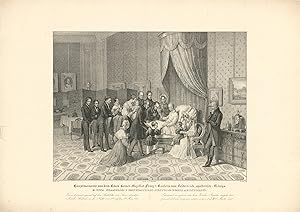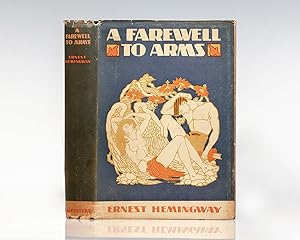a farewell to arms (Plus de 3 700 résultats)
Type d'article
- Tous les types d'articles
- Livres (3 684)
- Magazines & Périodiques (8)
- Bandes dessinées
- Partitions de musique (7)
- Art, Affiches et Gravures (23)
- Photographies (43)
- Cartes
-
Manuscrits &
Papiers anciens (17)
Etat
Reliure
Particularités
- Edition originale (422)
- Signé (42)
- Jaquette (350)
- Avec images (1 436)
- Sans impression à la demande (3 602)
Livraison gratuite
Pays
Evaluation du vendeur
-
Columbia s Legacy; or, Washington s valuable advice to his fellow citizens, published by him at the period of announcing his intention of retiring from public life at the expiration of the present constitutional term of the presidency of the United States. To which is added, his speech to the congress, at their present session, which terminates his political career.
Edité par Philadelphia, Sweitzer & Ormrod, December 10th, 1796
Vendeur : Antiquariat Steffen Völkel GmbH, Seubersdorf, Allemagne
Livre Edition originale
32mo (4 1/6 x 2 4/5 inches). Original presentation binding. Contemporary full red morocco with doube-fillet panels with corner floral designs, with the coat of arms of the United States gold stamped in the center of front and back panels, gilt lettered label "legacy" and gold ornamental designs and double-fillet on spine. 89, (7) pages. - A complete copy with half title and all blank leaves (D5, D8, F6-F8). Very rare first book edition of George Washington's last address to Congress printed only three days after the speech was held. Printed together with Washington's Farewell Address by the same printer who had published its first book edition only a few weeks before. The Eight Annual Address to the Congress was George Wasingont's last public appearance as President. He expressed his desire for peace with France and recommends the establishment of a national law to protect American commerce. Washington also advocates the creation of federal civilian and military universities, several years before the United States Military Academy, the first national military school in America, was established in 1802. Washington's last annual Address was first published in the Gazette of the United States on December 7, 1796. There is another book edition from the same year, printed by Ormrod and Conrad in Philadelphia but this edition does not include the Farewell Address. All contemporary editions of the last speech of George Washington are very rare. The American Antiquarian Society owns two copies of this first book edition, but both are incomplete. The Farewell Address is certainly the most important public message of Washington's life. It embodies the core beliefs that Washington hoped would continue to guide the nation. It was first printed in Philadelphia on September 19 1796 by David Claypoole's American Daily Advertiser. As Washington explained, "The name of American, which belongs to you, in your national capacity, must always exalt the just pride of Patriotism, more than any appellation derived from local distinctions." Washington feared that local factors might be the source of petty differences that would destroy the nation. Binding: "Decorated boards on American bookbindings from the latter part of the eighteenth century are very rare, primarily because of a trend that began in the 1760s, with the encreased availability of books, to shelve them upright, with their spines visible, rather than horizontally, with the edges of the pages exposed. . Stored in the new way, the covers were not visible and there was no purpose in decorating them. The only exceptions were presentation volumes, often kept out on a table." (Hekscher/Bowman - American Rococo. New York, 1992, p. 47) Our copy has a spectacular presentation binding which is one of the most spectacular and most desireable American bindings. Both covers have an early version of the coat of arms of the United States in the center. It is a combination of the versions by Charles Thomson and William Barton from the year 1782. Like in Thomson's version the eagle bears his wings downward, while the stripes on the shield are vertical according to Barton. Traditionally, the olive branch is held in the eagle s dexter, honorable, claw. On our binding the arrows are honorable and the olive branch is held in the eagle's less honorable or sinister claw. This mistake is quite important, as the olive branch is the symbol of peace and the arrows the symbol of war. The first appearance of this curious error was on the United States Quarter Eagle from September 1796. In an incredible blunder the designer Robert Scot mixed up the positions of arrows and olive branch. Supposing neither Scot nor the creator of our binding were militarists, the bookbinder of our copy was either inspired by the 1796 Quarter Eagle or independently makes the same mistake as Scot. The coat of arms of the United States is used to authenticate certain documents issued by the U.S. Federal Government. The present copy was certainly bound for official representation purposes and was most probably meant for a member of the Congress, even perhaps for George Washington himself. Most likely, the book was bound in the same place where it was published, Philadelphia. The first bookbinding with the Great Seal of the United States of America on its covers was bound 1783 in Paris and was one of the presentation copies for Benjamin Franklin of his French edition of the Constitutions of the First Thirteen States of the United States of America, which is now in the library of the University of Pennsylvania. Neither in Spawn's 'Bookbinding in America', nor in the collections of Maser or Papantonio is there any example of American bindings with the Great Seal of the United States or of any other American armorial bindings from the 18th century. Our copy is the first American binding with the arms of the United States of America on its covers and, at the same time, most probably the first American presentation binding for a member of the Congress of the United States of America. This is one of the most desirable early American bindings and certainly one of the most desirable copies of Washington's last speech in Congress or his Farewell Address. Bibliography: Evans 31545; Sabin 101578; French, Hanna D. French & William Spawn Bookbinding in Early America, Seven Essays on Masters and Methods. Worcester, 1986; Hellmut Lehmann-Haupt Bookbinding in America. Three Essays. New York, 1967; Hannah D. French Early American Bookbindings from the Collection of Michael Papantonio. New York, Pierpont Morgan Library, 1972; Catalogue Of Ornamental Leather Bookbindings Executed In America Prior To 1850. New York, Grolier Club, 1907. Sprache: Englisch Gewicht in Gramm: 550.
-
A Farewell to Arms
Edité par Charles Scribner's Sons, 1929
Vendeur : PEN ULTIMATE RARE BOOKS, Pine Plains, NY, Etats-Unis
Livre Edition originale Signé
Hardcover. Etat : Fine. 1st Edition. HEMINGWAY, Ernest: AN EXTRAORDINARY SIGNED HEMINGWAY RARITY. One of only 10 copies intended solely for his own private distribution of A Farewell to Arms. His first bestseller, this copy of Arms from the library of Owen Wister Jr., the father of Western fiction, author of the bestselling 1902 novel The Virginian. Hemingway held Wister in high regard, describing Wister s stories as a lesson to our generation in how to write, to his editor Maxwell Perkins. Arguably Hemingway s greatest work, A Farewell to Arms is the only Hemingway work issued in a signed limited edition. Five hundred copies were numbered and sold to the public. This is one of the ten unnumbered copies intended only for Papa s personal sharing. 8vo (222 x 146 mm). Full crushed blue morocco, covers twice ruled in gilt with gilt cornerpieces, upper cover reproducing the original design of the first trade edition dust jacket of this title by Cleon (1895-1979) in various color morocco onlays and gilt-work, flat spine lettered in white and blazing orange with a single vertical gilt filet and small gilt devices, edges gilt, hand-marbled endpapers, turn ins gilt, GILT STAMP-SIGNED BY SANGORSKI & SUTCLIFFE. Positively Sumptuous. We see no other such copy available for decades past. Book #vP1453. $43,500. We specialize in Rare Ayn Rand and other legends and landmarks of lifetimes. Signed by Author(s).
-
A Farewell To Arms.
Edité par Charles Scribner's Sons, New York, 1929
Vendeur : Raptis Rare Books, Palm Beach, FL, Etats-Unis
Edition originale Signé
First edition, first issue of this early Hemingway classic, which established him among the American masters. Octavo, original black cloth. Presentation copy, warmly inscribed by the author in the year of publication on the front free endpaper, "To Eleanor Havre from her friend Ernest Hemingway Paris October 18 1929." Near fine in a very good first state dust jacket with the misspelling "Katharine Barclay" in the blurb on the front flap. Housed in a custom half morocco clamshell box made by the Harcourt Bindery. Written when Ernest Hemingway was thirty years old and lauded as the best American novel to emerge from World War I, A Farewell to Arms is the unforgettable story of an American ambulance driver on the Italian front and his passion for a beautiful English nurse. Set against the looming horrors of the battlefield weary, demoralized men marching in the rain during the German attack on Caporetto; the profound struggle between loyalty and desertion this gripping, semiautobiographical work captures the harsh realities of war and the pain of lovers caught in its inexorable sweep. Ernest Hemingway famously said that he rewrote the ending to A Farewell to Arms thirty-nine times to get the words right. It is the basis for the 1932 film bearing the same name directed by Frank Borzage and starring Gary Cooper, Helen Hayes, and Adolphe Menjou.
-
Farewell To Arms,a - Arrow - Hemingway, Ernest, De Hemingway, Ernest. Editorial Arrow Books Ltd. En Ingl s, 1994
Edité par RANDOM HOUSE UK, 1998
ISBN 10 : 0099910101ISBN 13 : 9780099910107
Vendeur : Juanpebooks, MIAMI, FL, Etats-Unis
Livre
Etat : New. Libro nuevo, sellado, fisico, original. Enviamos a todos el mundo por USPS, Fedex y DHL. 100% garantia en su compra. Sealed, new. Unopened. 100%guarentee. We ship worldwide.
-
Farewell to Arms
Edité par Charles Scribners Sons, New York, 1929
Vendeur : Magnum Opus Rare Books, Missoula, MT, Etats-Unis
Livre Edition originale Signé
Hardcover. Etat : Fine. Etat de la jaquette : Fine. 1st Edition. SIGNED/LIMITED EDITION. A magnificent copy authentically SIGNED by Ernest Hemingway on the limitation page. The book is bound in the original publisher's cloth. The book is in excellent condition. The binding is tight with NO cocking or leaning and the boards are crisp with slight wear. The pages are exceptionally clean with NO writing, marks or bookplates in the book. A stunning copy SIGNED by the author with the ORIGINAL acetate dustcover and publisher's matching slipcase We buy SIGNED Hemingway First Editions. Signed by Author(s).
-
3 typed letters and 11 typed letters signed ("Buk," "Bukowski," and "Buk Buk Buk").
Edité par Los Angeles, July-November 1961., 1961
Vendeur : Antiquariat INLIBRIS Gilhofer Nfg. GmbH, Vienna, A, Autriche
Manuscrit / Papier ancien
4to. Together 23¼ pp. on 20 ff. With multiple manuscript emendations in different types of ink and crayon, 5 sketches, 1 black and white photograph of Bukowski, and 1 typed envelope. Correspondence archive addressed to the American painter and poet Kay "Kaja" Johnson, who was well known within the Beat community in San Francisco during the 1950s. In this extensive collection Bukowski discusses his literary endeavours, the indulgences and miseries of daily life, suicidal ideation, and his job at the Post Office, but above all he reflects on their shared preoccupation with poetry: "Poetry has been too much the exclusive territory of the wise who have turned out to be not so wise after all. Who wants to hear a rhyming poem when he is poised on the top of a building? Or a criticism of Keats? [.] Each poem, I think, should be as close to a suicide note as possible, saying what the mind must say and why [.]" (28 July 1961). Elsewhere, his daily observations verge on the poetic: "[Sometimes] I lift a tall can of beer and the coldness touches my insides and nobody is bothering with me. There Hemingway has gone down under the shotgun and I am standing in a dirty kitchen alive. This is important: standing in a dirty kitchen alive [.]" (28 July 1961). - After publishing a handful of stories in the mid-1940s, Charles Bukowski grew disillusioned with the literary world and descended into a decade of heavy drinking, a time he would later call his "lost years." This period was punctuated by painful physical ailments, including a life-threatening ulcer. This correspondence finds the author on the cusp of a newly productive period - working at the Los Angeles Post Office, and re-engaging with an assortment of alternative literary magazines. He addresses his literary forebears head on, including Hemingway ("I said Hemingway was spelled with one M. Why do you insist on 2? You are making him 2twice as heavy and he was overrated as it is [.] although all this does not include the very great book his only one A FAREWELL TO ARMS", 17 August 1961) and Henry Miller ("I think a person like Henry Miller [.] wanted too badly to become famous, wanted this more than the flow. He got his fame, and that's all it is: coins and carvings of fame; the light is out of his face, all the wires are cut [.]", "July something" 1961). - Fame and recognition are clearly on the author's mind, and they continue to be discussed in his characteristically irreverent manner. During his lost years, he tells Kaja that drinking was his poetry, he would "fall acroos [!] the rug drunk and beat my hands on the rug and scream, I AM A GODDAMN GENIUS AND NOBODY KNOWS IT BUT I" for the amusement of a companion (17 August 1961). Drunken outbursts aside, he speaks more candidly about his literary standing in America, going on to say: "I am glad the usa ignores me. Fame is bad, Kaja. I can think of very few people who remained as they were before fame. I thank god, any god, who has saved me from this thing [.]" (17 August 1961). These reflections on literary fame come on the heels of the publication of the author's first chapbook of poems in October 1960, entitled "Flower, Fist and Bestial Wail", and the impending publication of his second, announcing on 7 November: "My latest book is out (ha, ha, I can say latest now because this makes 2), LONGSHOT POMES FOR BROKE PLAYERS, from 7 Poets Press [.]". - Throughout this archive, Bukowski refers to his work with Jon Edgar Webb and The Outsider, as well as Targets, and assorted other small literary magazines (Quicksilver, Satis etc.), in addition to referencing Carl Larsen (who acted as editor for "Longshot Poems"), Caresse Crosby and the Black Sun Press, Sheri Martinelli, and others. - Kaja Johnson was an established poet in her own right, and Bukowski praises her writing: "I told Jon [Webb] I thought your poem in OUTSIDER #1 one of the best, which it was, saying the odd things [.]" (28 July 1961). When their correspondence picks up, Kaja is living in New Orleans, and Bukowski attempts to put her in touch with the writer John William Corrington, then teaching at LSU. Bukoswki s letter of "August 14, I think" references an impending move ("Are you going to France or New York? or Los Angeles? or where?"), followed by a vague hope she might move to California ("I hope you settle in Frisco because then I can leap from my window and meet you there on the way to the ground [.]", 17 August 1961), only to write to her in Paris shortly afterwards: "To sit backwards in your bed, writing to Kaja in Paris, and thinking of hot buttered garlic frenchbread [.]", "Sept. ending" 1961). In Paris, Kaja took up residence at the so-called Beat Hotel on 9 Rue Gît-le-C ur in the Latin Quarter. Throughout the 1950s and 1960s, the previously run-down and unnamed hotel became a haven for artists, writers, poets, and musicians, including some of the biggest names of the Beat movement: Allen Ginsberg, Peter Orlovsky, William S. Burroughs, and Gregory Corso. - The rough sketches are caricatures of himself at his typewriter smoking a cigarette, frequently with a can of beer close by. - Occasional light soiling, rust where previously paper clipped, previously folded as expected. A fine group of early letters from the laureate of American lowlife.
-
A Farewell to Arms
Edité par Charles Scribner's Sons, New York, 1929
Vendeur : Magnum Opus Rare Books, Missoula, MT, Etats-Unis
Livre Edition originale Signé
Hardcover. Etat : Fine. 1st Edition. First Edition, limited to 510 copies, of which this is number 497, and SIGNED by the author. A superlative copy bound in the original Publisher's half-vellum over light blue paper-covered boards, with leather spine label titles in gilt. The book is in excellent condition with the text unopened and UNREAD. The pages are exceptionally clean with NO writing, marks or bookplates in the book. A fabulous copy SIGNED by Ernest Hemingway on the limitation page. Includes the original patterned paper slipcase with red label at front, that is hand-numbered 497 that matches the number in the book. Signed by Author(s).
-
A Farewell to Arms
Edité par Charles Scribner's Sons, New York, 1929
Vendeur : Burnside Rare Books, ABAA, Portland, OR, Etats-Unis
Edition originale Signé
Etat : Near Fine. Signed Limited First Edition. First edition, limited issue. Copy #398 of a limited 510, signed by Ernest Hemingway on the limitation page. Publisher's pale green paper covered boards over vellum spine, black leather title label to spine stamped in gilt, in publisher's leaf-patterned slip case with red title label to front panel with matching number. Near Fine with slight toning to binding, light soiling and wear to spine, several small nicks to the bottom edge. In Near Fine publisher's original slipcase with light rubbing and light toning. A beautiful copy of the only signed limited edition ever issued of Hemingway's work. Hanneman 8B.
-
A Farewell to Arms
Edité par SCRIBNER'S, NEW YORK, 1929
Vendeur : Vagabond Books, A.B.A.A., PASADENA, CA, Etats-Unis
Livre Edition originale Signé
Hardcover. Etat : Very Good. Dust Jacket Included. First Edition. A very good first edition in first issue dust jacket. INSCRIBED BY HEMINGWAY in Paris 1929. Signed by Author(s).
-
A Farewell to Arms (Signed limited edition)
Edité par Charles Scribner's Sons, New York, 1929
Vendeur : Whitmore Rare Books, Inc. -- ABAA, ILAB, Pasadena, CA, Etats-Unis
Edition originale Signé
Etat : Near Fine. First edition. Number 244 of 510 copies of the signed, limited edition, printed on large paper. Available simultaneously with the trade edition. Original half japon, over paper boards, black morocco spine label. Spine head bumped, small skinning to head of spine label, binding faintly toned. Slight rubbing and wear to slipcase. Housed in the publisher's leaf-patterned slipcase, and additionally housed in a custom yellow morocco clamshell. "Written when Ernest Hemingway was thirty years old, and lauded as the best American novel to emerge from WWI, A Farewell to Arms is the unforgettable story of an American ambulance driver on the Italian front, and his passion for a beautiful English nurse. Set against the looming horrors of the battlefield, this gripping, semi-autobiographical work captures the harsh realities of war and the pain of lovers caught in its inexorable sweep. Hemingway famously rewrote the ending to the novel 39 times to get the words right. The result is what the Washington Times called 'a towering ornament of American literature'" (Hemingway Library). Grissom A.8.1.a2; Hanneman A8b. Near Fine.
-
A Farewell to Arms
Edité par Charles Scribner's Sons, New York, 1929
Vendeur : Burnside Rare Books, ABAA, Portland, OR, Etats-Unis
Edition originale Signé
Signed limited first edition. First edition, limited issue. Copy #167 of a limited 510, signed by Ernest Hemingway on the limitation page. [x], 355 pp. Bound in publisher's pale green paper covered boards over vellum spine, black leather title label to spine stamped in gilt, housed in publisher's leaf-patterned slipcase with red title label to front panel with matching number. Near Fine with toning to boards, slight darkening to spine vellum, residue from removed bookplate on paste down, in Near Fine slipcase, lightly edge-worn. An attractive copy of the only signed limited edition ever issued of Hemingway's work. Hanneman 8B.
-
A FAREWELL TO ARMS
Edité par Charles Scribner's Sons, New York, 1929
Vendeur : Charles Agvent, est. 1987, ABAA, ILAB, Fleetwood, PA, Etats-Unis
Edition originale Signé
Hardcover. First Edition. Original vellum spine and green boards with vellum tips. Copy #48 of 510 SIGNED by the author, Hemingway's only signed and limited edition. An absolutely gorgeous copy, the boards and the vellum both sparkling fresh with the black leather label completely intact and bright. Housed in a new and attractive slipcase reproducing the original and on which the original limitation label has been mounted. Laid in are receipts for purchase of this book from 1932 (private purchase for five dollars) and 1984 (Goodspeed's). A beautiful, Fine copy of this desirable book in an attractive new slipcase.
-
Ernest Hemingway, Who Narrowly Survived Two Plane Crashes Just the Year Before, and Who Died by Suicide, Reflects on Death: ?Maybe we are only alive when we are dead but I have not believed that for a long time.? (In an unpublished letter of Hemingway, offered here for the first time, a remarkable statement of Hemingway on the religious afterlife)
Vendeur : The Raab Collection, Ardmore, PA, Etats-Unis
?When you are dead you are dead for a long time."?He advises a young woman friend, ?Please be careful about aircraft?It is one of the great pleasures of life but you pay off accordingly.??Hemingway will send her an animal skin from his African safari to decorate her new house"?Our trophies ( sic ) were shipped July 18th from Mombassa via Amsterdam to be trans-shipped to NY and then here."After covering the Spanish Civil War, in 1939 Hemingway purchased Finca Vig?a (?Lookout Farm?), an unpretentious estate outside Havana, Cuba. In 1940 he published ?For Whom the Bell Tolls?, which many consider his best book. All of his life Hemingway was fascinated by war - in ?A Farewell to Arms? he focused on its pointlessness, and in ?For Whom the Bell Tolls? on the comradeship it creates. During World War II, he flew several missions with the Royal Air Force and landed with American troops on D-Day. He saw a good deal of action in Normandy and in the Battle of the Bulge. He also participated in the liberation of Paris. Following the war in Europe, Hemingway returned to his home in Cuba and turned his attention to writing again. He also traveled widely, and at the end of their 1953-1954 African safari, the Hemingways survived a near-fatal plane crash, only to have their rescue plane crash the very next day. Though they survived the second crash as well, newspapers around the world carried brought the details to the reading public.Soon after, he received the Pulitzer Prize in fiction for ?The Old Man and the Sea?, a short heroic novel about an old Cuban fisherman who, after an extended struggle, hooks and boats a giant marlin only to have it eaten by voracious sharks during the voyage home. That book also played a role in gaining for Hemingway the Nobel Prize for Literature in 1954. It ran in its entirety in five million copies of Life Magazine, and the 50,000 copies printed in book form sold out in ten days.In 1955, back in Cuba, Hemingway turned fifty-five and tried to follow his doctors? advice by reducing his drinking. In October it is announced that he has been awarded the 1954 Nobel Prize in Literature. All of his wife?s? efforts to protect his privacy were sabotaged by the crush of worldwide press and the fact that Hemingway invited any and all to the Finca Vigia to visit. In the summer of 1955 he was working on the filming of ?The Old Man and the Sea? starring Spencer Tracy. The pace of people and press, of lunches and drinking, finally takes its toll and in the autumn of 1955 Hemingway took to his bed for two months, suffering from hepatitis and nephritis.Hemingway's relationship with faith was complicated. Raised protestant, he converted to catholicism but was largely religiously indifferent. He had seen so much death and tragedy. At this point evidently, he had long since abandoned the faith of his youth.Mary Lou Firle, a second year student at CCNY, was in Cuba in early 1955. Before she left she bet a friend that she would have Ernest Hemingway sign the book she had, ?Farewell to Arms.? She picked up the phone and called Ernest Hemingway. When he answered she introduced herself and added, ?I have a friend at Fordham University.? Hemingway immediately assumed the friend was Prof. Bob Brown who had been in touch with Hemingway on several occasions. Brown was writing a book or articles about Hemingway. Hemingway told Mary Lou that his wife Mary was away and he had to entertain visitors from the French Embassy that afternoon. He asked her if she would come to his home and help him. Mary Lou agreed and Hemingway sent his driver to pick her up.After the meeting the group drove her back to Havana. Hemingway invited her back the next day for lunch and sent his driver to pick her up. They spent the afternoon talking. She had told him of her family background, that her parents were born in Germany. Since she had been at Veradero Beach for a week she had a deep tan, and Hemingway called her the ?Black Kraut.? The reason for the nickname, Hemingway said, was that he called his good friend, Marlene Dietrich, the famous German actress, ?Kraut?; so Mary Lou, who was very tan, would be the ?Black Kraut.? Later that day Hemingway?s driver drove her back to Havana. The two exchanged letters in July 1955. She wrote him again in October and received this response.In the summer of 1955 he was working on the filming of ?The Old Man and the Sea? starring Spencer Tracy. The pace of people and press, of lunches and drinking, finally takes its toll, and he was grateful to have the weather interrupt the filming. Hemingway famously rewrote the ending to "A Farewell to Arms" numerous times, and that is possibly the writing he refers to.Typed letter signed, with typewriter corrections and a pencil notation by Hemingway, Finca Vigia, San Francisco de Paula, Cuba, October 6, 1955, to Mary Lou, on his fear of flying and unbelief in the afterlife, signed EH, with the original envelope sending it. He also jokes about the equity that hurricanes are named invariably after women.?Thank you for writing and I wish to congratulate your mother and your new step father if they would like that. I hope they are happy. With a good daughter like you they should be.?Am very happy you took your vacation up north as down here it was rugged with the effects of the different hurricanes. Hope we are not going to have Za-Za. I knew a girl named Janet once but she never killed any people in Barbados nor Tampico. It is easy to get tired of this naming tropical storms after girls and I think it is in bad taste especially when you have been through bad tropical storms.?Please be careful about aircraft. If I ever see you will tell you how and why. It is one of the great pleasures of life but you pay off accordingly. No second thoughts will help you and when you are dead you are dead for a long time. Maybe we are only alive when we are dead but I have not believed that for a long time. Excuse me if I am pedantic about aircraft but everybody is pedan.
-
A Farewell to Arms. Signed by Hemingway - No. 208 of the 510 limited copies.
Edité par N.Y:Scribners. 1929. Hardcover., 1929
Vendeur : Frederick Bayoff Literary Books, Adrian, MI, Etats-Unis
Certified to be correct and signed by Louis Henry Cohn-owner of The House of Books who wrote the first bibliography of Hemingway Fine. Finde DJ, Slipcase. Pages uncut. No markings in or out. Please email for info concerning any book or dust jacket. If d.j. does not appear in description, it means there is no dust jacket. Photos on request. Some books may have remainder marks. Heavy and/or oversized books require additional.
-
The Essential Ernest Hemingway: On the Sea, Fish, Writing Books and Screenplays, Filming His Book ?The Old Man and the Sea?, Cuba, and Containing a Certain Proposition (?I have to concentrate on it all August heat or no heat as must start photography at sea of fishing for The Old Man and The Sea. We have a chance to make a great picture with patience, fortitude and very much luck.?)
Vendeur : The Raab Collection, Ardmore, PA, Etats-Unis
?You need an awful lot of luck when working with the sea and with fish.??A fascinating, unpublished letter obtained by us directly from the recipient?s familyOn HemingwayAfter covering the Spanish Civil War, in 1939 Hemingway purchased Finca Vig?a (?Lookout Farm?), an unpretentious estate outside Havana, Cuba. In 1940 he published ?For Whom the Bell Tolls?, which many consider his best book. All of his life Hemingway was fascinated by war - in ?A Farewell to Arms? he focused on its pointlessness, and in ?For Whom the Bell Tolls? on the comradeship it creates. During World War II, he flew several missions with the Royal Air Force and landed with American troops on D-Day. He saw a good deal of action in Normandy and in the Battle of the Bulge. He also participated in the liberation of Paris. Following the war in Europe, Hemingway returned to his home in Cuba and turned his attention to writing again. He also traveled widely, and at the end of their 1953-1954 African safari, the Hemingways survived a near-fatal plane crash, only to have their rescue plane crash the very next day. Though they survived the second crash as well, newspapers around the world carried brought the details to the reading public. Soon after, he received the Pulitzer Prize in fiction for ?The Old Man and the Sea?, a short heroic novel about an old Cuban fisherman who, after an extended struggle, hooks and boats a giant marlin only to have it eaten by voracious sharks during the voyage home. That book also played a role in gaining for Hemingway the Nobel Prize for Literature in 1954. It ran in its entirety in five million copies of Life Magazine, and the 50,000 copies printed in book form sold out in ten days.In 1955, back in Cuba, Hemingway turned fifty-five and tried to follow his doctors? advice by reducing his drinking. In October it is announced that he has been awarded the 1954 Nobel Prize in Literature. All of his wife?s? efforts to protect his privacy were sabotaged by the crush of worldwide press and the fact that Hemingway invited any and all to the Finca Vigia to visit. In the summer of 1955 he was working on the filming of ?The Old Man and the Sea? starring Spencer Tracy. The pace of people and press, of lunches and drinking, finally takes its toll and in the autumn of 1955 Hemingway took to his bed for two months, suffering from hepatitis and nephritis.On his friend Mary LouA young American naval officer named Morris was on a training mission with the military and a liberty stop was scheduled for Havana, Cuba, in late January 1955. Mary Lou Firle, his girl friend at the time, and later his wife, was then a second year student at CCNY, and she arranged a trip Cuba so they could meet in Havana. She went a week earlier and stayed at Veradero Beach outside Havana with some other students. Their place at the beach cost $1.00 per day. Before she left she bet a friend that she would have Ernest Hemingway sign the book she had, ?Farewell to Arms.? Mary Lou and boyfriend Morris met in Havana. They went to the famous El Floridita for daiquiris and had dinner. She wore pants (slacks) which were unusual for ladies at the time. The next day they went to Veradero Beach. His ship departed on Sunday.A day or so Later Mary Lou telephoned Ernest Hemingway. When he answered she introduced herself and added, ?I have a friend at Fordham University.? Hemingway immediately assumed the friend was Prof. Bob Brown who had been in touch with Hemingway on several occasions. Brown was writing a book or articles about Hemingway. Hemingway told Mary Lou that his wife Mary was away and he had to entertain visitors from the French Embassy that afternoon. He asked her if she would come to his home and help him. Mary Lou agreed and Hemingway sent his driver to pick her up.At the meeting a member of the group, possibly the ambassador, said she looked familiar and that he had seen her at the Floridita with a naval officer. She stood out because she wore pants. After the meeting the group drove her back to Havana. Hemingway invited her back the next day for lunch and sent his driver to pick her up. They spent the afternoon talking. When Hemingway asked her about Prof. Brown, she replied, ?Who is Professor Brown?? She said she knew one of his students. Hemingway laughed really hard about that and her ?trick.? She had told him of her family background, that her parents were born in Germany. Since she had been at Veradero Beach for a week she had a deep tan, and Hemingway called her the ?Black Kraut.? The reason for the nickname, Hemingway said, was that he called his good friend, Marlene Dietrich, the famous German actress, ?Kraut?; so Mary Lou would be the ?Black Kraut.? Later that day Hemingway?s driver drove her back to Havana.In the Spring of 1955 Mary Lou, a friend and Morris met Professor Brown at his home on Long Island. When Mary Lou wrote to Hemingway about a possible trip to Cuba in the Summer, he wrote back to discourage the trip (too hot in Cuba). He told about how busy he was with his film, ?The Old Man And The Sea,? adding that ?You need an awful lot of luck when working with the sea and with fish.?Hemingway?s letter to his black krautTyped letter signed, Finca Vigia, San Francisco de Paula, Cuba, July 29, 1955, to Mary Lou. ?I don't think August is a good time to take a vacation in Cuba . It is cooler here in the hills than any place except the sea but last night it was so hot I couldn't sleep. The trade winds are not blowing and the general weather plan for July has been very hot mornings in town and moderately cool here until lately; then rains starting at noon. For two weeks the first part of July it rained nearly all day day and night. This was good for the farm because we had had a seven months drought. But it is poor vacation weather. August promises to be very hot and probably with rains in the afternoons. You would be much better off to take a vacation somewhere in the north where it should be cool by then. That heat spell.
-
Farewell to Arms
Edité par Charles Scribner's Sons, 1929
Signé
Hardcover. Etat : Near Fine. SIGNED LIMITED edition. This being #12 of 510 copies of which 500 were for sale and 10 for presentation. Book near fine, minor tanning on covers, book very fine on inside, pages still uncut at top. Housed in a custom-made elaborate fold-out case. Signed by Author(s).
-
Greatest Masterpieces of AMERICAN LITERATURE 100 vols
Edité par Franklin Library, 1980
Vendeur : Fine Binding Books, Barker, TX, Etats-Unis
Livre
Full-Leather. Etat : Near Fine. Various Artists (illustrateur). A limited edition published under the auspices of the American Revolution Bicentennial Administration. ** Distinctive Cover Design, Profusely Illustrated; Moire Endleaves, Satin Ribbon Page Marker; Accented in Real 22KT Gold, Gilded Page Edges; Smyth-sewn Pages for Strength and Durability; Long-lasting, High Quality Acid-neutral Paper; These are the books that have shaped the cultural heritage of our nation ? that have made American literature admired and respected throughout the world. More important, these are the works that will remain the cornerstones of our culture for centuries to come. For these literary masterpieces have no equal. They represent the greatness of America: (Partial List) Typee by Herman Melville // 48 Collected Poems and 3 Essays on Poetry by Edgar Allan Poe // 1919 by John Dos Passos // Collected Poems by W. H. Auden // Abraham Lincoln His Speeches and His Writings // The Adventures of Huckleberry Finn by Mark Twain // Walden or Life in the Woods by Henry David Thoreau // Essays (1st & 2nd Series) by Ralph Waldo Emerson // The Autobiography of Benjamin Franklin // Leaves of Grass by Walt Whitman // Abraham Lincoln by Carl Sandburg // Moby Dick by Herman Melville // The Federalist American State Papers // The Great Gatsby by F. Scott Fitzgerald // Poems of Ralph Waldo Emerson // An American Tragedy by Theodore Dreiser // Common Sense, The American Crisis and The Age of Reason by Thomas Paine // Uncle Tom's Cabin or Life among the Lowly by Harriet Beecher Stowe // The Adventures of Tom Sawyer by Mark Twain // A Farewell to Arms by Ernest Hemingway // The Grapes of Wrath by John Steinbeck. ** SHIPPING CHARGES: Domestic USA shipping is as quoted (almost free); International shipping requires extra (anywhere from $1000-$1200).
-
A Copy of ?A Farewell to Arms?, the Classic Novel of Love During Wartime, Signed by Ernest Hemingway for a Young Woman Friend Whom He Compared to Marlene Dietrich (She had traveled to Cuba, decided to call him, elicited an invitation to his home, and entertained guests with him over a few days)
Vendeur : The Raab Collection, Ardmore, PA, Etats-Unis
Written when Ernest Hemingway was thirty years old and lauded as the best American novel to emerge from World War I, ?A Farewell to Arms? is the unforgettable story of an American ambulance driver on the Italian front and his passion for a beautiful English nurse. Set against the looming horrors of the battlefield, this gripping, semi-autobiographical work captures the harsh realities of war and the pain of lovers caught in its inexorable sweep. Hemingway famously rewrote the ending to "A Farewell to Arms" thirty-nine times to get the words right.Mary Lou Firle, a second year student at CCNY, was in Cuba in early 1955. Before she left she bet her future husband that she would have Ernest Hemingway sign the book she had, ?A Farewell to Arms.? In Cuba, she picked up the phone and called Ernest Hemingway. When he answered she introduced herself and added, ?I have a friend at Fordham University.? Hemingway immediately assumed the friend was Prof. Bob Brown who had been in touch with Hemingway on several occasions. Brown was writing a book or articles about Hemingway. Hemingway told Mary Lou that his wife Mary was away and he had to entertain visitors from the French Embassy that afternoon. He asked her if she would come to his home and help him. Mary Lou agreed and Hemingway sent his driver to pick her up.After the meeting the group drove her back to Havana. Hemingway invited her back the next day for lunch and sent his driver to pick her up. They spent the afternoon talking. She had told him of her family background, that her parents were born in Germany. Since she had been at Veradero Beach for a week she had a deep tan, and Hemingway called her the ?Black Kraut.? The reason for the nickname, Hemingway said, was that he called his good friend, Marlene Dietrich, the famous German actress, ?Kraut?; so Mary Lou, who was very tan, would be the ?Black Kraut.? Later that day Hemingway?s driver drove her back to Havana. The two exchanged letters in July and October 1955.Mary Lou?s copy of ?A Farewell to Arms?, publisher Scribner?s, 1953 publication date, inscribed and signed ?To Mary Lou Firle, with all best wishes, and much affection from her friend, Ernest Hemingway. Finca Vigia, San Francisco de Paula, 3 February 1955.?This book has been in Mary Lou?s family?s possession since it was received, and we acquired it direct from them. Mary Lou had promised Hemingway that she would not sell the book during her lifetime and kept her promise. She told her family it would be ok to sell it after she passed.
-
A FAREWELL TO ARMS
Edité par Charles Scribner's Sons, New York, 1929
Vendeur : Rare Book Cellar, Pomona, NY, Etats-Unis
Edition originale
Hardcover. First Edition; First Printing. Very Good+ in a Very Good+ dust jacket. First Issue with 'Katharine' misspelling on front flap. Page x is blank and does not contain the legal disclaimer that did not arrive in time, Scribner seal present on copyright page. "2.50" price on front flap inctact. Light chip, stain at spine heel. Rubbing, few small open tears along panel edges. Light foxing on top/bottom text block edges. ; 355 pages.
-
A Farewell to Arms
Edité par Charles Scribner's Sons, New York, 1929
Vendeur : T. A. Borden Books, Olney, MD, Etats-Unis
Edition originale Signé
Hardcover. Etat : Very Good. First Edition. Signed limited edition, #82 of 510 in new clamshell box with period design interior paper lining , deckle edge paper, new leather spine label made to match the original, stain on the second endpaper where a chip of the old spine label rested for years. Vellum spine is lightly evenly soiled. Hemingway's signature is bold and clear. ; Scans available on request ; Signed by Author.
-
Ukazanie va nej ih prime atel nostej na puti ego imperatorskogo vyso estva gosudarja naslednika Cesarevi a ("Places of interest on the route of his Imperial Majesty the Crown Prince").
Edité par St Petersburg: In the Military Printing House, 1837, 1837
Vendeur : Peter Harrington. ABA/ ILAB., London, Royaume-Uni
Rare first and sole edition of this highly important account of a tour of Russia undertaken by the future Alexander II, the Tsar-Reformer, "the first heir to the throne to have personally seen the vast country he would rule" (Radzinsky, p. 60). With the armorial bookplate, incorporating the arms of Leuchtenberg, of Alexander's sister, the remarkable Grand Duchess Maria Nikolaevna. Alexander (1818-1881, reigned 1855-1881) was tutored by Pushkin's mentor Vassily Zhukovsky, one of the foremost Russian Romantic poets of the era. "When Zukovsky began his tutoring, Alexander was only seven. Zhukovsky devoted himself totally to the royal scion. The poet wrote to his sister, 'My real duty will take up all my time. Farewell forever to poetry with rhyme. A poetry of another sort lies ahead of me.' In his hands lay the future of Russia. Zhukovsky put together a ten-year plan of 'Journeys,' as the poet called the heir's education". Zhukovsky's scheme succeeded and the future tsar did well with his exams. "Now, according to the plan, the education was to be polished by two very important journeys. First Sasha would travel around his own country. He would travel for over six months around Russia's roadless expanses" (ibid.). Before departing, Zhukovsky made a speech, declaring that "Russia is a book, but an animate one. Your Imperial Highness will be reading it, but at the same time, it will be learning about its reader. This mutual comprehension is the true goal of this voyage". As he travelled throughout the European part of Russia, "the heir to the throne was met reverently by thousands of people wherever he went. As he travelled along the Volga in the Kostroma region, people stood knee-deep in the river for hours to get a glimpse of their earthly god. The tsarevich was the first Romanov heir to visit Siberia, where convicts and exiles were sent. He travelled around Russia for seven months, visiting thirty provinces. It was still not enough to cover the vast country, but at least now he had an idea of the boundless land he was to rule" (ibid.). As emperor, Alexander's most significant act was the Emancipation Reform of 1861, which effectively abolished serfdom in Russia. His experiences during the tour of 1837 had a profound effect on his thinking; in addition to the example of Zhukovsky, who, although not a rich man, had chosen to free his own serfs. Alexander's sister, Grand Duchess Maria Nikolaevna (1819 1876), was also educated by Zukhovsky, and became an accomplished watercolourist, as well as taking a keen interest in interior design. She was an avid art collector and in 1852 became president of the Imperial Academy of Arts. Unusually for her time she made a marriage for love, with Maximillian, duke of Leuchtenberg. On Maximillian's death in 1852, Maria made a secret and morganatic match with Count Grigori Stroganov, a further reflection of her open-mindedness and the influence, perhaps, of Zhukovsky. Alexander turned a blind eye to the marriage and, as Radzinsky remarks, "since the emperor could not permit his sister's misalliance, he paid special attention to her children by her first marriage, who lived in St Petersburg without their mother". Edward Radzinsky, Alexander II: The Last Great Tsar (2006); no copies recorded on WorldCat. Octavo (205 x 123 mm). Contemporary green half skiver, Spanish pattern marbled sides, smooth spine lettered and decorated in gilt. Old typed catalogue description loosely inserted. Shelfmark of the Russian National Library to spine. A light judicious restoration at spine ends and joints, gilt improved, contents clean and umarked. A very good copy indeed in a pleasing contemporary binding.
-
A Farewell to Arms.
Edité par New York: Charles Scribner's Sons, 1929, 1929
Vendeur : Peter Harrington. ABA/ ILAB., London, Royaume-Uni
Edition originale
First edition, first printing, in the attractively preserved dust jacket designed by Cleonike Damianakes (1895-1979), renowned for her classical-style cover art for Lost Generation writers. The first printing is without the legal disclaimer which appeared in the second and third printings on p. x. Based on Hemingway's experiences as an ambulance driver at the Italian Front during the First World War, it was written at the peak of his success and met with wide acclaim. The critic James Aswell offered particularly lavish praise: "I have finished A Farewell to Arms, and am still a little breathless, as people often are after a major event in their lives. If before I die I have three more literary experiences as sharp and exciting and terrible as the one I have just been through, I shall know it has been a good world" (cited in Bloom, p. 5). Grissom A.8.1.a; Hanneman 8a. Harold Bloom, ed., Ernest Hemingway's A Farewell to Arms, 2009. Octavo. Original black cloth, printed gold paper labels on spine and front cover, fore edge untrimmed. With dust jacket by Cleonike Damianakes. Brentano's bookseller ticket on rear pastedown. Spine head bumped, faint ring stain on rear cover, lightly affecting jacket, contents clean; bright, unclipped jacket a little rubbed and nicked, singular small chip and closed tear, faint splash mark on front flap: a near-fine copy in like jacket.
-
A Farewell to Arms by Ernest Hemingway First Edition Book Second Issue 1929
Vendeur : Iridium_Books, DH, SE, Espagne
Etat : Used - Good.
-
A Farewell to Arms.
Edité par New York Charles Scribner's Sons, 1929
Vendeur : Shapero Rare Books, London, Royaume-Uni
Livre Edition originale
First edition, first printing, first issue dust-jacket; 8vo; publisher's black cloth, gold paper title labels to upper board and spine printed in black, minor indentations to upper board, very mild, partial browning to endpapers, in nicked and very lightly tanned dust-jacket, in all a very good copy. A really good copy in the correct dust-jacket with the name 'Katherine Barclay' so spelled on the front flap.
-
A Farewell to Arms
Edité par Charles Scribner's Sons, New York, 1929
Vendeur : Magnum Opus Rare Books, Missoula, MT, Etats-Unis
Livre Edition originale
Hardcover. Etat : Fine. Etat de la jaquette : Fine. 1st Edition. First Edition, First printing with the publisher's "Seal" printed on the copyright page. A magnificent copy. This ORIGINAL dustjacket is rich in color with NO chips or tears. This First Issue sophisticated dustjacket has the $2.50 printed price present. The book is in fabulous shape. The binding is tight with NO cocking or leaning and the boards are crisp. The pages are exceptionally clean with NO writing, marks or bookplates in the book. A stunning copy of this TRUE FIRST EDITION in collector's condition. We buy Hemingway first editions.
-
A Farewell To Arms : Kassette / Fold-Out-Case, angefertigt für die Limited Edition (500 Copies For Sale - 10 Copies for Presentation) :
Edité par New York, Charles Scribner's Sons :, 1929
Vendeur : Versand-Antiquariat Konrad von Agris e.K., Aachen, Allemagne
Art / Affiche / Gravure
Kassette (ca. 30 x 25cm). Etat : Sehr gut. 1 Äußerst seltene Kassette / Fold-Out-Case, angefertigt für die Limited Edition For Presentation (10 Copies) / For Sale (500 Copies) von "Farewell To Arms", New York 1929; Holz-Kassette mit Leder-Optik, in Buchform mit goldgeprägtem Titel, Rückentitel und floralen Motiven; die dem Schnitt des Buches entsprechenden Flächen in Goldfarbe; die Kassette ist mit weinrotem Samt ausgeschlagen; Deckel leicht lagerspurig / berieben mit geringen Abriebstellen, Rücken mit 2 etwas größeren (ca. 1cm) Abriebstellen des Bezugs; Samtbezug sehr gut, im vorderen Deckel mit kleiner Abriebstelle; im Ganzen mit altersgemäß noch sehr gut bewertetes Exemplar dieser hervorragenden Rarität für Hemingway Fans . Als Versandart wählen wir immer eine schnelle Option (in Deutschland Brief oder DHL-Paket, ins Ausland Warenpost oder DHL-Paket). Preis inkl. MwSt. Sprache: Englisch Gewicht in Gramm: 1102.
-
A Farewell to Arms [limited signed editon]
Edité par Charles Scriber's Sons: NY, 1929
Vendeur : John K King Used & Rare Books, Detroit, MI, Etats-Unis
Signé
Hardcover. Etat : Very Good. 9.25 x 6.25", half vellum; boards, 355pp, covers rubbed, vellum darkened, tiny stain to lower fore-corner of front cover, covers unevenly sunned, extremities bumped, hinges loose, two bookplates from former owners and one signature/date on front fly from former owner, slight moldy scent though still a good copy, in a newer (not original) slipcse; LIMITED TO 510 NUMBERED COPIES, SIGNED BY THE AUTHOR, ERNEST HEMINGWAY. Signed by Author(s).
-
A FAREWELL TO ARMS [Signed]
Edité par Charles Scribner's Sons, New York, 1929
Vendeur : Second Story Books, ABAA, Rockville, MD, Etats-Unis
Edition originale Signé
Hardcover. Limited Edition: #165/510. Octavo, 355 pages. In Very Good minus condition. Bound in publisher's half vellum over green cloth board with black gilt morocco lettering label on spine. Housed in later, some mild rubbing and toning to slipcase. "#529" written on spine of slipcase. Light rubbing to spine and corners of boards, light soiling to boards. Bookplate to front pastedown. Interior with moderate consistent foxing and finger-staining. Limited Edition, one of 510 signed copies, this being number 165, signed by Hemingway. Hemingway signature offset onto half-title. Shelved in Case 3. The only signed, limited edition of any of Hemingway's works. Derived in part on Hemingway's experiences in Italy during World War I, the character of Catherine Barkley was based on a nurse who cared for him when he was wounded serving as an ambulance driver at the front. They had planned to marry, but she ultimately rejected his proposal when he returned to the United States. While not as strictly autobiographical as The Sun Also Rises, Farewell to Arms continued Hemingway's practice of blending real, lived experience with fiction: a significant inspiration for the novel was a collection of wartime correspondence between a friend (Frederic Agate) and his wife. References: Hanneman A8b. 1371304. Shelved Dupont Bookstore.
-
Hauptmomente aus dem Leben Sr. Majestät Franz I. Kaisers von Oesterreich.
Edité par Vienna, Lithographisches Institut, (1833-1836)., 1836
Vendeur : Antiquariat INLIBRIS Gilhofer Nfg. GmbH, Vienna, A, Autriche
Series of 21 lithographs, ca. 700 x 500 mm each. A complete set of this "extremely popular lithographic series" (cf. Telesko, p. 163) which was first announced in September 1831: originally, a total of twenty prints showing "principal moments" from the life of Emperor Franz II (I) were planned, to be issued at monthly or bi-monthly intervals. Even at this point early versions of the first and second plate were available, and the third would be published in October (cf. Wiener Zeitung 214 [29 Sept. 1831], p. 1214). From 1833 onwards, the title "Hauptmomente" was used (instead of the previous "Lebensmomente" or simply "Momente"), demonstrating that the present set was issued after this point. In what must have been a departure from the artists' original plan, the set was completed after Franz's death with two plates showing the Emperor on his death-bed, bidding his family farewell (the 20th leaf) and his burial in the crypt of the Augustinerkirche (the 21st and final leaf). Hoechle, the illustrator, died only months after Emperor Franz, and he is said to have sketched the latter scene on the spot and finished the drawing as one of his very last works. In commemoration, the lithographer Wolf added a portrait of his late colleage at the picture's far right, with his sketching portfolio under his arm. The original watercolours, measuring but a quarter of the lithographs' size, were part of the Imperial Fideikomissbibliothek until the early 20th century and now repose in the Albertina (cf. Huber-Frischeis, p. 472f.). - "Hoechle's suite offers a selection from the principal events in the life of the emperor, a mixture of ceremonial events (crownings), acts of charity, battles, triumphal entries, encounters with other monarchs, and homages by the estates [.] Wolf's series was instrumental in shaping the posthumous public image of the ruler by creating a canonical epic in pictures" (cf. Telesko, p. 191). - Dust- and waterstained, edges and margins limp and frayed, some tears (occasionally touching the caption). Rarely encountered complete with all plates, as here: only three incomplete sets traced in the last decades' auction records. - Wurzbach IX, 91. Huber-Frischeis/Knieling/Valenta, Die Privatbibliothek Kaiser Franz' I. von Österreich 1784-1835 (2015), p. 472-483. Telesko, Geschichtsraum Österreich I, p. 163, 191 & passim.
-
A Farewell To Arms.
Edité par Charles Scribner's Sons, New York, 1929
Vendeur : Raptis Rare Books, Palm Beach, FL, Etats-Unis
Edition originale
First edition of this early Hemingway classic, which established him among the American masters. Octavo, original black cloth. Fine in a near fine first state dust jacket with the misspelling "Katharine Barclay" in the blurb on the front flap. A very sharp example of this highspot of American literature. Written when Ernest Hemingway was thirty years old and lauded as the best American novel to emerge from World War I, A Farewell to Arms is the unforgettable story of an American ambulance driver on the Italian front and his passion for a beautiful English nurse. Set against the looming horrors of the battlefield weary, demoralized men marching in the rain during the German attack on Caporetto; the profound struggle between loyalty and desertion this gripping, semiautobiographical work captures the harsh realities of war and the pain of lovers caught in its inexorable sweep. Ernest Hemingway famously said that he rewrote the ending to A Farewell to Arms thirty-nine times to get the words right. It is the basis for the 1932 film bearing the same name directed by Frank Borzage and starring Gary Cooper, Helen Hayes, and Adolphe Menjou.


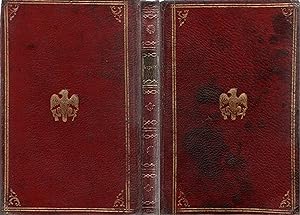
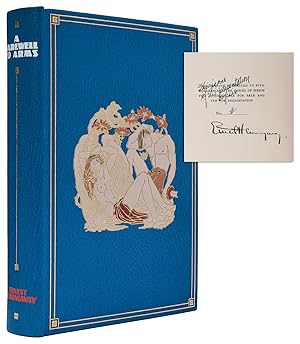

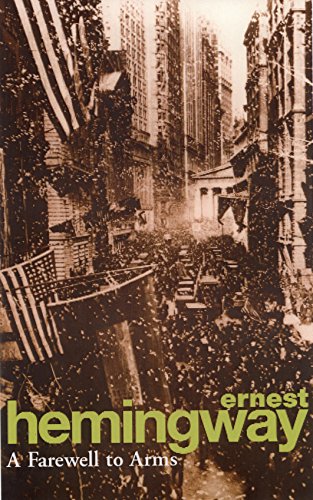

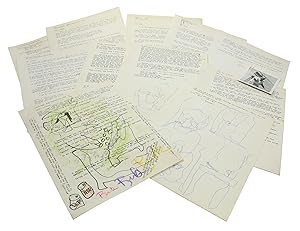
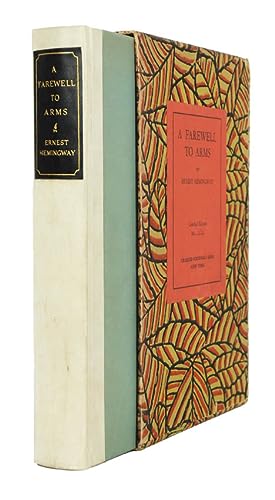
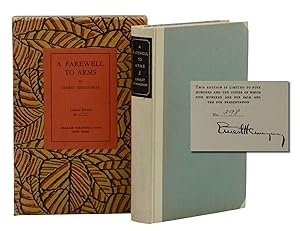
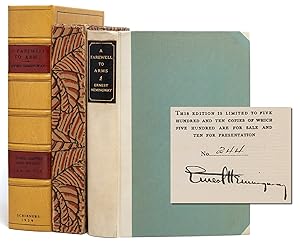
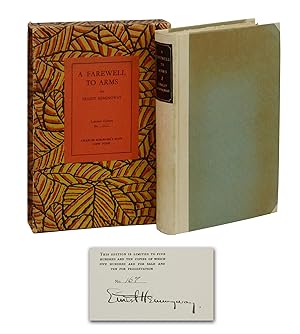

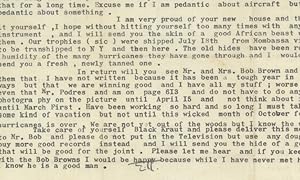
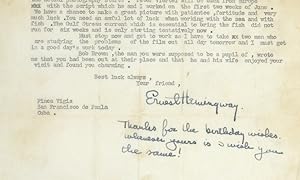
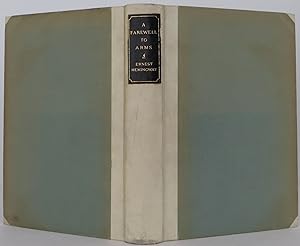
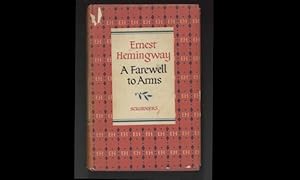
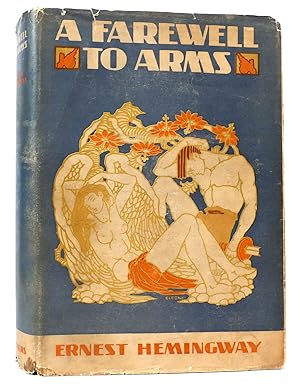
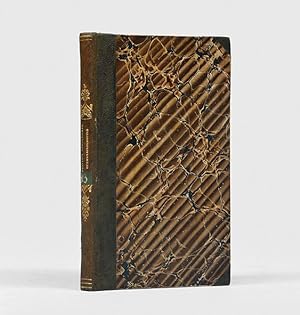
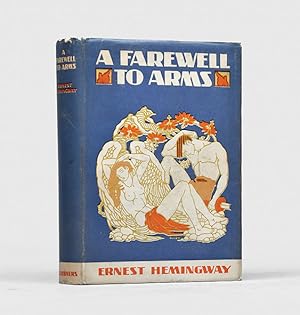
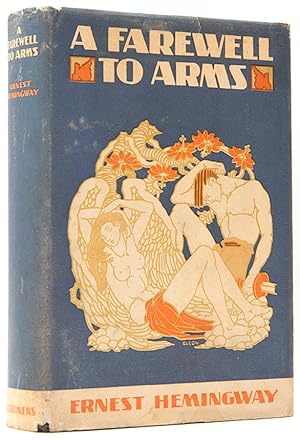
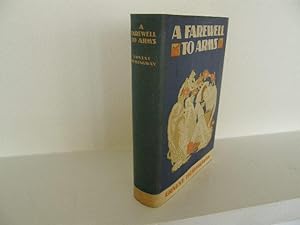
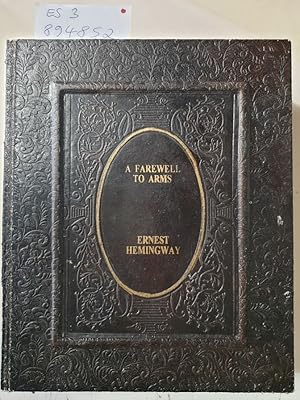
![Image du vendeur pour A FAREWELL TO ARMS [Signed] mis en vente par Second Story Books, ABAA](https://pictures.abebooks.com/inventory/md/md31616304059.jpg)
